Where should you focus your time and money in the pursuit of new clients? We asked six designers for their top tips.
When you quiz designers about how they get new clients, “word of mouth” is a common refrain. It’s an industry based largely on repeat business and referrals—but that doesn’t mean you have to wait for the phone to ring (or inbox to ping). While those referrals are often enough to keep design firms busy for years, there’s no shortage of other means to drum up leads when there is a lull.
Doing It for the ’Gram

Ready to dig in?
This article is available exclusively for
BOH subscribers and BOH Insiders.
BOH subscribers and BOH Insiders.
Want full access?










































